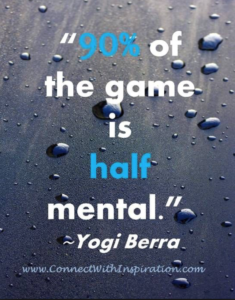What is Visualization?
Visualization is known as guided imagery, meditation, and by many other names. A popular visualization for athletes is the mental rehearsal of sporting events while ‘intending’ a desired outcome. Amazingly, research has revealed that visualization can actually enhance performance to nearly the same extent as physical practice.
How does Visualization work?
With each experience, a neural pathway is formed. Neural Pathways in short, are clusters of neurons in the brain that work together to create a memory or a learned behavior. Dr. Blaslotto explained, “As your brain conceives of an act, it generates impulses that prompt neurons to ‘perform’ the movement being imagined by transmitting those impulses from the brain to the muscles.” This in turn creates a habit, or neural pathway in the brain, programming your body’s actions as if you physically performed the activity….
Define Your Specific Intention
Visualization puts your intention on what you want to achieve. The more specific the intention, the more specific the results. Remember whatever you believe is what your body will do. So when you are thinking of your intention make sure it is:
- Clear
- Specific
- Achievable
- You feel, know, and trust it can be accomplished (or is being accomplished)
Take Responsibility
- Trying to do visualization without taking responsibility will prove to be futile experience. To accomplish what you want you must take action and responsibility. Visualization usually takes about 6 weeks to work. It is done once in the morning and before bedtime. Some people do see or feel results the very first time but remember everyone’s body and mind are different and so is the way they process information so have patience.
- Be accountable to and for yourself
- Make a commitment
- Do visualization regularly
- Be persistent and patient
- Keep positive
Get Mentally Relaxed
- A relaxed state puts allows you direct access to your subconscious mind. Here are some steps to help you relax:
- Find a quiet place.
- Relax in a favorite chair or lie down.
- Get comfortable and loosen clothing.
- Uncross your arms and legs.
- Get centered by focusing on the breath and breathing (this activates the vagus nerve which is the major quieting nerve in the body).
- Your intention should be to totally relax your body and mind.
Sample Visualization
In order for Visualizationsto be most most beneficial, it should be repeated at the beginning or end of every practice for several weeks.
Like the actual physical practice, a little bit of visualizations here and there may do some good, but for the best result skaters should make this a routine part of their training. This means practicing visualizations outside of practice as well as at home, repeating to yourself the things that they wish to internalize, such as “I am a really fast skater” and “I give well-placed and well-timed hits”. Here is an excellent basketball reference for how to make this exercise the most beneficial: “You need to visualize everything out of your eyes (in the 1st person). You have to be there at the free throw line feeling the basketball. Seeing the goal. Hearing the noise. As you shoot, you should FEEL the ball roll off your fingers. You should SEE the ball traveling through the air with perfect backspin. You should SEE your hands out in front of you with the perfect follow through. You should SEE your hands out in front of you holding the follow through as you HEAR & SEE the ball swish through the net.” (2)
So if we apply this to say, jamming, you have to be there on the track, see that pack in front of you, visualize the space IN FRONT of the pack that you are going to occupy, feel your skates on the hardwood floor, see your own body move fluidly through all the holes, hear your quick feet on the track, physically possess the feeling of sprinting out of the pack. Skaters need to focus while they do this, really meditate on each thing that they are visualizing.
Visualization Process:
- First, have all of you skaters sitting comfortably in front of you with their eyes closed.
- Think of or speak your intention out loud.
- Pick a positive affirmation from the sample list below.
- Remember to talk and experience the visualization in the first person (“I”).
- Close your eyes and imagine yourself in the game
- Watch yourself as your body performs
- Feel the game taking place.
- Try using all of your senses: smell, touch, hearing, sight, taste. The more senses you use, the more vivid the experience will be.
Sport psychology researchers (Holmes and Collins, 2002), recommend using a basic 7-element system, which can help you create a great visualization “script” for yourself.
It’s called PETTLEP:
- Physical – picture your physical self, in your skates, uniform, and gear, mouthguard in, teammates around you.
- Environment – use every detail of where your bout takes place – the correct floor, the light levels, the announcers’ voices, where the stands and the benches are, where your coach is standing…
- Task – imagine details “relevant to the task”, like the actions of other skaters, paying attention to their jammer AND the incoming offensive player, the track lines, etc. Don’t imagine yourself playing against elite skaters unless you’re at that level – everything about your imagery should be specific to the situations you are likely to experience yourself.
- Timing – real-time imagery seems to be the most effective way to achieve functional equivalence in your brain, but it can also be effective to run certain elements or skills in slow-mo: say, approaching the pack and squeaking across the inside line on your toe stoppers. A jammer may want to slow that down to mentally review each step in the sequence. But then review it again in real time to cement the image.
- Learning – change your visualization script over time to adapt to your own skill improvements – as you get better in real life, don’t forget to make yourself better in your imagination too!
- Emotion – include the emotions you are likely to feel on the track, in your mental script. Stick to positive emotions like adrenaline and determination, rather than fear or nervousness.
- Perspective – use a first person perspective for skills that involve timing (like a juke, or conversely stepping into an oncoming jammer), and a third person perspective, in other words like seeing yourself on film, for skills that involve positioning, like reconnecting with your wall, or skating very low. Either way, plan in advance whether you will see the game unfold from your own eyes on the track, or from an outside perspective, before you begin your visualization.
Sample Positive Affirmations:
(these are just suggestions and you should definitely modify/add/customize to your own team’s needs):
- I am a good skater
- I am a skilled skater
- I am an excellent skater
- I am a fast skater
- I am a really fluid jammer
- I am a really good blocker
- I am great at booty blocking
- No one gets past my booty
- No one can break through my walls
- I am the best blocker I can be
- I am amazing at holding the inside line
- I give hard hits
- I give well-placed and well-timed hits
- I am not afraid of getting hurt
- I am not afraid of getting hit
- I improve every practice
- I never doubt my skills
- I support other skaters
- Other skaters support me
- I perform really well in front of an audience
- The audience does not distract me
- I respect my fellow skaters
- My fellow skaters respect me
- My team needs me
- We’re all in this together
- I am confident on my skates
- Every time I make a mistake I learn something new
- I am a strategic player
- I am great at playing roller derby
- I love roller derby!
References:
Roller Derby Specific Positive Visualization http://www.allderbydrills.com/2011/07/positive-visualization.html
Visualization and Sport Performance http://www.articlesbase.com/sports-and-fitness-articles/visualization-and-sports-performance-1660889.html
Visualization and healing of the body http://healing.about.com/od/visualization/a/powerofmind.htm
Create your own visualizations to win http://www.rollerderbyathletics.com/imagine-winning/
Basic 7 element PETTLEP system http://www.birmingham.ac.uk/Documents/college-les/sportex/imagery/Introductiontoimagery-teachersnotes.pdf




